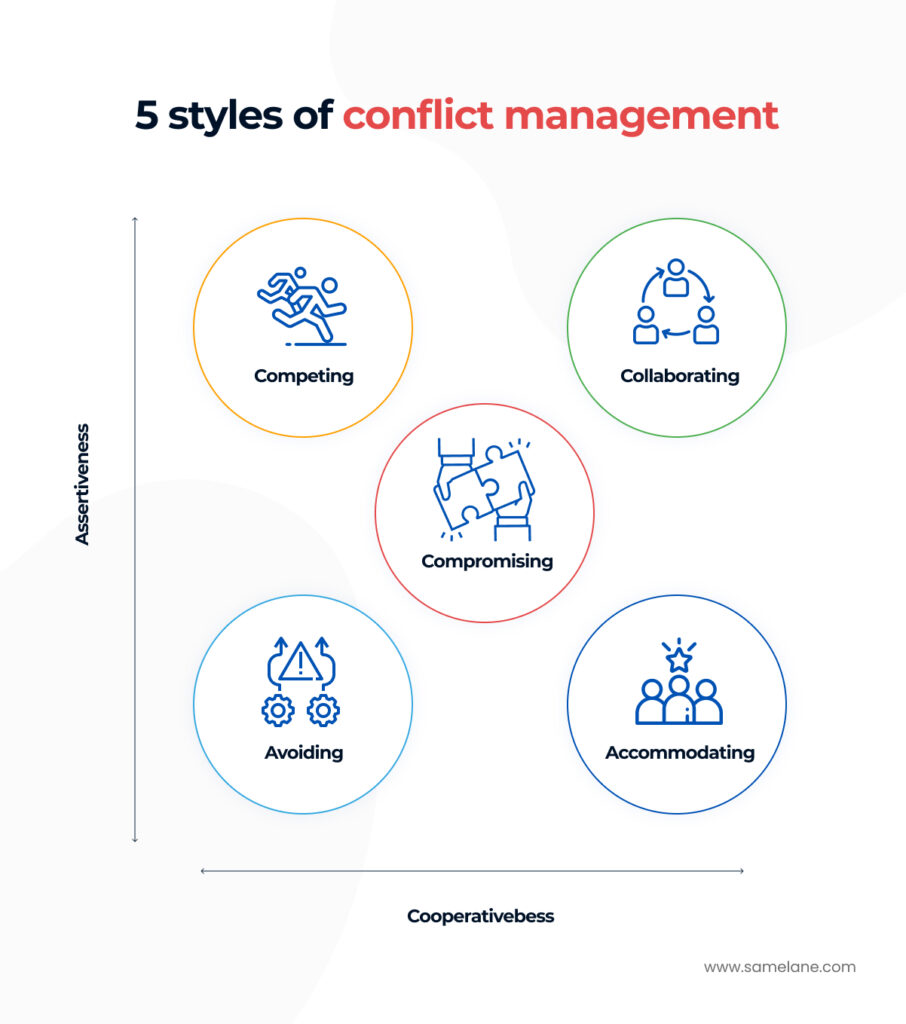We’ve already discussed the importance of business fundamentals such as effective communication and adequate management styles in previous articles. Sometimes, a cooperative workplace atmosphere proves very challenging to maintain, even if you make sure to follow best practices. In such a case, you should be prepared for conflict management. We will elaborate on the possible ways of handling working environment discords, keeping in mind the interest of all parties involved.
What is conflict management?
Before we get on with the conflict management strategies, let’s specify what is understood by the term. The process of conflict resolution focuses on limiting a disagreement’s negative outcomes. Proper handling of difficult situations takes specific soft skills like active listening, patience, and emotional intelligence to recognize the source of the conflict and then manage it sensibly and impartially. Workplace disputes are nothing extraordinary and should be treated as such. Diverging opinions, incompatibilities, or competing interests, despite the actual cause, conflicts can and should be managed effectively. Understanding conflicts and how to resolve them is an invaluable ability to build a good leader.
What’s the goal of conflict management?
Protracting conflicts are detrimental to the work environment; that’s nothing new. The earlier we address the issue, the better for the whole team. However, finding a quick resolution to a conflict and calling it a day does not necessarily do the trick, as improperly handled issues eventually resurface. The main objective of conflict management is to reduce the adverse outcomes of the dispute and find a mutually beneficial solution for each party. A secondary effect of conflict management is the enhanced effectiveness of a team that can carry on with their tasks, relieved of personal tensions. But how to reach a solution that will be generally acknowledged as satisfactory and definitely conclude the argument? Let’s look into the five main techniques you might find handy when tackling workplace drama.
5 styles of conflict management
Arguments are integral to every workplace; thus, identifying and managing them sensibly is a valuable skill to master if you’re aiming to be a good manager. When the conflict is adequately handled, minimizing its negative impact is very likely. Although there is no versatile solution to all kinds of issues, applying one specific method suited to the problem will resolve the issue for good. Here are the five most commonly used conflict management styles applicable in every work environment.

Accommodating conflict management style
This method is probably the least confrontational one; thus, the easiest one to adopt. The accommodating conflict management style aims to find quick solutions to minor problems. Basically, the style presumes that for the sake of moving on, the other party’s needs should be put ahead of one’s own. This way, you don’t waste time on a prolonged conflict; everyone can return to their tasks. This highly cooperative approach is suitable when facing small issues where you don’t want to invest your time. The way to go is to find a middle ground and be willing to compromise. Seamless as it may seem, the accommodating style might be seen as passive, therefore adverse strategy toward conflict solution. Being compliant at all times gives way to pushing boundaries and taking advantage of the less contentious party.
Avoiding conflict management style
Opposite to the cooperative way of handling conflicts is the avoidance method. According to this approach, arguments can be reduced or even solved by ignoring the fact that it has occurred. Pretending not to see the elephant in the room might be challenging in the long run; hence the next step in neutralizing the uncomfortable atmosphere is to isolate the conflicting parties. Again, it’s another idea for evading confrontation, which can help cool down the heads but will not bring any resolution. Postponing or simply dodging disputes is another behavior typical of the avoidance style. It might work in terms of a minor issue that is not worth being bothered with, though applying this method when facing serious problems is no different from burying one’s head in the sand. Avoiding confrontation equals putting it off, which in turn leads straight to conflict growth and its relapse. Overall, we would not recommend applying this method when dealing with bigger issues, as it is doomed to fail and will most likely lead to conflict de-escalation and a frustrated team.

Competing conflict management style
Competing approach is characterized by a strong stance and the urge to settle things in favor of the party pushing for the conflict resolution. The side resorting to a competing management style rejects the idea of compromise and is rather uninterested in the opinions and needs of the other party. Exercising this approach means no less than getting your way by all means; hence associations with an autocratic management style are entirely justified. Despite the self-centered character of the style, the competing conflict management style proves itself applicable when there is no time to discuss possible options and final decisions have to be made instantly. The competing approach also seems legitimate when you need to stand up for your values, end a long-lasting animosity or prevent a harmful decision from being made. Drastic measures come at a price; in the case of imposing unpopular decisions, it may lower team morale and, consequently, work efficiency.
Collaborating style of conflict management
If you’re looking for gratifying long-term results and have enough time to reflect on each party’s needs and arguments, reach for the collaborating method of solving conflicts. It is a time-consuming process requiring patience and negotiation skills to meet the needs of all parties involved and, at the same time, address all their perspectives and arguments. This approach is well suited when dealing with an impactful decision, multiple perspectives must be addressed and respected, and good relations between the sides are maintained. The cooperation-oriented style creates a safe environment for mediation and is the most advanced way to make a decision that everyone is satisfied with. However, it does not prove right when you’re pressed for time and dealing with strong-minded, adamant adversaries. In such cases, reaching a satisfactory solution may become a long-lasting battle of the unpersuadable.
Compromising conflict management style
This style of conflict management lies in the middle of the already depicted approaches; it draws a bit of both cooperativeness and assertiveness. The compromising style of conflict management aims at reaching an agreement at the expense of both parties, as they are expected to give in a bit for a solution that at least partially pleases everyone involved. It’s a popular and convenient approach when facing a short deadline for decision-making, being in a deadlock, or seeking a temporary solution for a given moment. Obviously, this method works best when both parties are willing to cooperate, and reaching a solution is their primary objective. Despite the conciliatory character and quick results, we recommend not overusing it, as constant compromises may lead to general discontent and frustration. Not without reason, the compromising conflict management style is also called a “lose-lose” resolution.
How to manage conflicts? 5 practical steps on your way to a conflict solution
Conflicts are prone to happen in any working environment, and they’re a natural part of communication in a team. If handled well, they’re providing a great opportunity for growth and development for your team. In order to cope with workplace conflicts, it’s important to understand what kind of argument we’re facing. Sure, conflict management strategies are crucial, but they won’t apply well in a non-cooperative team. Hence, a good leader must exercise soft skills for conflict management and emotional intelligence resources to handle the conflicted parties. Here are some useful tips on how to approach a conflict and deduce the best management style to apply in each case.
Stay calm and keep the dialog going
For starters, take a step back and make sure you can take a rational approach to the situation. Maintaining impartiality is essential for leading a conflict toward resolution and, at the same time, remaining credible to your team.
Investigate the situation
Try to find out the origins and source of the conflict, what happened, and who was involved. Approaching the case, try not to jump to conclusions prematurely; instead, listen actively to understand all points of view and differentiate perceptions from facts. Determine the cause based on credible sources only.
Let everyone have their say
Hear out all parties’ arguments with respect and focus on actual events. Being a facilitator also means you must approach the discussion assertively, which means you don’t take any sides and are clear about your expectations toward the sides involved.
Identify options and agree on a way forward
After you get acquainted with the conflict reasons and both sides’ rationale, it’s time to decide how to tackle the dispute. Mutually agreed solutions usually work best and last longer, as all parties have approved them. Identify whether you’re dealing with a major issue or trivia to pick the best strategy. Can it be solved immediately in one sitting, or maybe you need to organize a series of dedicated meetings? Are you dealing with a conflict already hitting a boiling point, or do emotions allow for a peaceful discussion? Knowing the answers, you will be able to decide on the most suitable of all available conflict management strategies.
Find a common goal, agree on the solution, and implement
After identifying how the problem can be solved, ensure each party is aligned with the arrangement. It is the manager’s part to determine a solution; however, the responsibility for its delivery belongs to all parties involved.
What is the best conflict management style?
Each conflict is based on numerous variables, which definitely should be considered when choosing the best management method for handling a difficult situation. There is no universal approach to solving workplace disputes, though understanding the conflict kind and source will enable you to apply the suitable method. The five conflict management styles covered in this article display how to resolve arguments in the most productive way. It’s worth keeping in mind that conflicts may end up as a formative experience if handled well.











